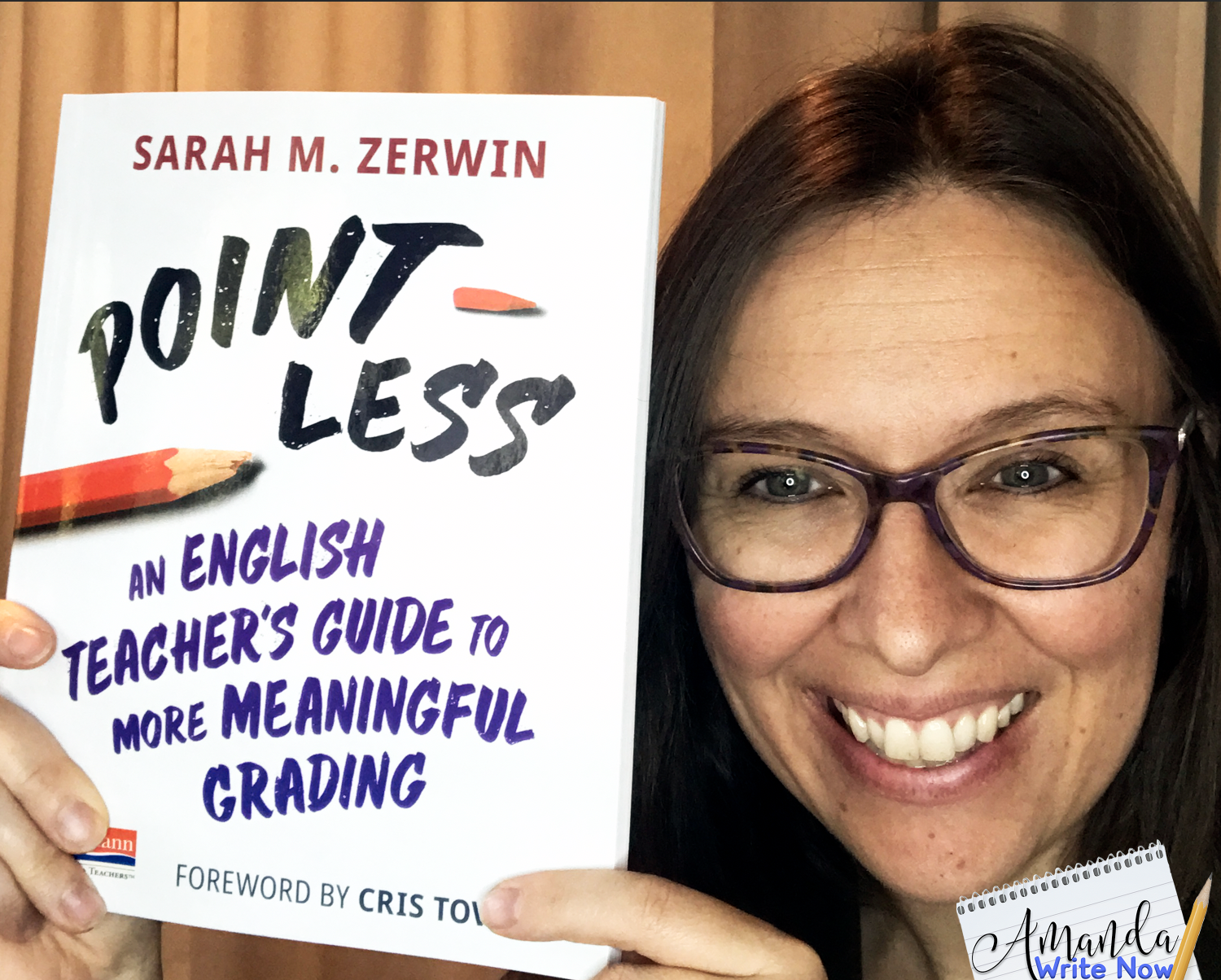
So, you want to know how to quit grading so much? Or maybe you just want your grading process to be more systematic and meaningful for students. Well, reading this blog post is the first step to making both of these things happen!
My mission is to make teachers’ lives easier. I resigned from teaching because of COVID-19. After making this huge decision one question has been on my mind constantly…how can I help teachers?
Let’s get honest here. Teaching during a pandemic is mind-numbing, tedious, and terrible! Sitting on a screen with students or having to teach with a mask on…this is an awful time to be a teacher. If you are continuing to have a positive attitude, you amaze me!
One of the ways to ease teachers’ stress is by reducing the grading burden. Below, you’ll find 6+tips for how to stop grading so much. Some of the tips are obvious but that’s okay. Teachers need reminders just like students.
You’ll also find ideas I gleaned from an amazing book called Point-less An English Teacher’s Guide to More Meaningful Grading by Sarah M. Zerwin. This book is a game changer for teachers because Zerwin documents exactly how teachers can work within their school’s grading policies to make grading more meaningful.
I believe we can both stop grading so much and make the way we grade more meaningful!
*Note: The link to this book is an Amazon Affiliate link. This means that if you purchase the book through my link, I will receive a commission for that purchase. I only recommend books I’ve read from start to finish and that I love.
1. Find Out What’s Required
How many grades do you have to input into your grade book a week, a month, a quarter, a semester? Are the grades supposed to be grades for mastery or completion or a combination? If this isn’t detailed in your school’s policy, don’t ask. Just grade the majority of the work on completion.
But, what if your district requires a certain amount of your grades should only demonstrate mastery?
Well…
Recently I read a book called Point-less An English Teacher’s Guide to More Meaningful Grading by Sarah M. Zerwin. This is one of the best professional development books I’ve ever read. I highly recommend it to all teachers who want to involve their students more in the learning and assessment process and teach real-life skills. I’m pretty sure that is all workshop teachers!

In her book, Zerwin argues that using points to demonstrate mastery stifles growth, learning and the individual journeys students take to become readers and writers in real life, beyond the classroom.
If you are required to input grades based on if students are mastering skills or not, there is another way to go about it that doesn’t stifle growth and learning…
Zerwin demonstrates how the grade book can become a collection of “data points” that don’t impact students’ final grade and only function as a way to reflect to students and their families how well students are keeping up with the work.
But, what about mastery points?!?
Zerwin details a process of helping students choose two learning goals at the beginning of the grading period (one skill based goal and one habit based goal). Once students choose their goals they spend the rest of the grading period, tracking their growth, writing reflections and filling out Google forms commenting on their own work. These comments can then be copied and pasted directly into the grade book by the teacher. Zerwin says that all of this makes the learning and growth students are doing visible, whereas points don’t reveal any of the learning and growth that is taking place.
As the final weeks of the grading period draw near, students write a letter in the form of a story to the teacher. In this letter-story the student becomes the protagonist. There are antagonists and conflicts that get in the way of the student (protagonist) reaching their chosen learning goals. There is also a resolution that includes what letter grade the student thinks they should receive.
In the letter-story, students also utilize the data points and comments accumulated in the grade book to support why they think they should get that particular grade.
The teacher ultimately has the final say and can utilize the data points, comments, reflections and the letter to determine a final grade for students that takes into account so much more than points assigned with a rubric ever can!
2. Use an All-in-One Assessment Tool

What if you could utilize just one tool for your pre-assessment, checklist, student self-assessment, peer assessments, conferring, and final rubric!?!?
Doing this could help both you and students understand what is expected during a unit. It could give students a clear idea of what they will learn and be able to do by the end of a unit. Using an all-in-one assessment tool will also give you a common language and vocabulary to discuss the skills you are teaching and your students are learning. At the beginning of your unit, have students highlight the vocabulary on the all-in-one assessment tool they don’t know so you can use that information to figure out what mini lessons students need.
One of the skills listed on this all-in-one assessment tool could also become a skill based goal that students choose to work on individually throughout the unit. You could require that students write reflections in Google forms or their writing notebooks about their progress meeting that skill based goal throughout the unit.
It’s also important to teach students the difference between grades that are based on completion versus mastery. I’ve included a handy poster you can use to explain this concept to students and the various assessments you do throughout a unit below. Again, all of these assessments could be done using the all-in-one-assessment tool above!

3. Only Grade 1-3 Skills
Just because you have 10 skills listed on a rubric, doesn’t mean you have to grade all of them! Here are some ideas for what skills you might choose to grade, rather than trying to grade all of them.
- Grade the skill students struggled with the most on their pre-assessments.
- Grade the skill students chose as their individual skill based goal at the beginning of the unit.
- Ask students to pick a skill they feel they did particularly well in and grade that! Have students highlight the skill in green that they want to be graded on.
- Grade a combination of the above.
Maybe you are wondering how only grading 1-3 skills on a rubric will add up to enough points for a final end of unit evaluation? All you have to do is double the points. So, change the 4 to be worth 40, the 3 to be worth 30 and so on. You could also weight the final writing piece more than the other smaller assignments and reflections you had students do throughout the unit. These other assignments could include things such as pre-assessments, brainstorms, drafts, providing peer feedback and participating in conferences with the teacher.
4. Involve Students
I love this quote from Point-less An English Teacher’s Guide to More Meaningful Grading:
Students should be the single most important users of classroom data about their learning. They should know for themselves what they know, what they need to learn, and how they are progressing.– Sarah M. Zerwin
So, how do we involve our students in the grading process more? We should involve students not only because it’s important for them to reflect on their learning but also to ease the grading burden of teachers. Here are a few ideas:
- Have students self-assess using your all-in-one assessment tool at the beginning of the unit based on the pre-assessment and at the end of the unit before they turn their final piece in
- Use the Google Doc comments feature to have students highlight and comment where they demonstrate the skills from the all-in-one assessment tool in their writing
- Tell students to use suggesting mode in Google Docs when revising so you can visually see the changes they made
- Allow opportunities for students to reflect on what they are learning, obstacles they are facing and how they plan to move forward with their learning goals
5. Use Google Forms
Google Forms can grade for you, provide students instant feedback on how they are comprehending and allows students to comment/reflect on how they are doing. All of this information can be displayed on a spreadsheet.
There are two brilliant ideas for using Google Forms I found from Point-less. The first idea was to provide short answer or paragraph questions in your Google Form. These questions can ask students to write reflections about how they are doing with whatever concept you’ve been teaching. Once students have filled this out, you can copy and paste student answers from a Google Form straight into the comments section of your grade book! This way families and students can see how students are doing and it’s in their own words!
The second brilliant idea I found in Point-less was to use Google Forms for reading quizzes and grade these on completion, not mastery! So, students get full credit for just doing the quiz. Instead of grading quizzes on mastery, set up your quiz to allow students to see their score instantly after taking the quiz (the video below explains how to do this). Then have students write a reflection about why they think they missed the questions they did and what they will do going forward to make sure they are comprehending the book/story in the future.
Here is a video that explains how to use Google Forms in the way I described above!
6. Limit Grades for Mastery
Grading based on completion is simple. It only involves checking if students did the work. Grading for mastery is much more complex and takes time. Grading for mastery should require involving students much more in the process.
Here are some writing and reading assignments that you might consider grading based on completion not mastery:
- Brainstorming
- Drafts
- Reading responses
- Reflections
- Quick Writes
- Showing up for a conference
- Discussions
- Participating in peer conferences
Consider only grading the following on mastery:
- Skills listed on your rubric
- Revision process
- Final reflections written by students about their goals/learning journey
Bonus Ideas:
- Students should be writing and reading much more than you are able to grade.
- Don’t comment in the margins of students’ papers. Doing so takes too long and is often tedious. Instead, write a short paragraph at the end of a final paper that provides just one or two tips for the revision process.
- You don’t have to read every students’ every word! Skimming is okay especially if you are just grading 1-3 skills from your rubric.
- Consider not grading Socratic Seminars or discussions in general. This way students become more willing to have meaningful conversations and take risks in those conversations! Grade these discussions based on participation and completion. Give all students full credit, even if they only participated by observing.
Related Posts:
How I Cut My Grading Time by 10 Hours
13 Creative Assessment Ideas for Reading, Writing, Speaking & Listening
10 Ways to Make Grading Easier
Final Thoughts
Grading can be simple and it can be more meaningful! All English teachers have the ability to work within their school’s required policy. We just need to get creative and think out of the box. Hopefully, this blog post has helped you do just that. Check out this video I created that captures this blog post in video form:

0 Comments